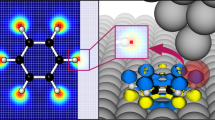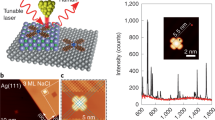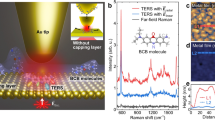Abstract
Unambiguous chemical identification of individual molecules closely packed on a surface can offer the possibility to address single chemical species and monitor their behaviour at the individual level1,2,3. Such a degree of spatial resolution can in principle be achieved by detecting their vibrational fingerprints using tip-enhanced Raman scattering (TERS)4,5,6,7,8,9,10. The chemical specificity of TERS can be combined with the high spatial resolution of scanning probe microscopy techniques11,12,13, an approach that has stimulated extensive research in the field14,15,16,17,18,19,20,21,22,23,24,25,26,27,28. Recently, the development of nonlinear TERS in a scanning tunnelling microscope has pushed the spatial resolution down to ∼0.5 nm, allowing the identification of the vibrational fingerprints of isolated molecules on Raman-silent metal surfaces13. Although the nonlinear TERS component is likely to help sharpen the optical contrast of the acquired image, the TERS signal still contains a considerable contribution from the linear term, which is spatially less confined. Therefore, in the presence of different adjacent molecules, a mixing of Raman signals may result. Here, we show that using a nonlinear scanning tunnelling microscope-controlled TERS set-up, two different adjacent molecules that are within van der Waals contact and of very similar chemical structure (a metal-centred porphyrin and a free-base porphyrin) on a silver surface can be distinguished in real space. In addition, with the help of density functional theory simulations, we are also able to determine their adsorption configurations and orientations on step edges and terraces.
This is a preview of subscription content, access via your institution
Access options
Subscribe to this journal
Receive 12 print issues and online access
$259.00 per year
only $21.58 per issue
Buy this article
- Purchase on Springer Link
- Instant access to full article PDF
Prices may be subject to local taxes which are calculated during checkout



Similar content being viewed by others
References
Atkin, J. M. & Raschke, M. B. Optical spectroscopy goes intramolecular. Nature 498, 44–45 (2013).
Gottfried, J. M. Where does it vibrate? Raman spectromicroscopy on a single molecule. Angew. Chem. Int. Ed. 52, 11202–11204 (2013).
Schmid, T., Opilik, L., Blum, C. & Zenobi, R. Nanoscale chemical imaging using tip-enhanced Raman spectroscopy: a critical review. Angew. Chem. Int. Ed. 52, 5940–5954 (2013).
Anderson, M. S. Locally enhanced Raman spectroscopy with an atomic force microscope. Appl. Phys. Lett. 76, 3130–3132 (2000).
Hayazawa, N., Inouye, Y., Sekkat, Z. & Kawata, S. Metallized tip amplification of near-field Raman scattering. Opt. Commun. 183, 333–336 (2000).
Pettinger, B., Picardi, G., Schuster, R. & Ertl, G. Surface enhanced Raman spectroscopy: towards single molecular spectroscopy. Electrochemistry 68, 942–949 (2000).
Stockle, R. M., Suh, Y. D., Deckert, V. & Zenobi, R. Nanoscale chemical analysis by tip-enhanced Raman spectroscopy. Chem. Phys. Lett. 318, 131–136 (2000).
Berweger, S. & Raschke, M. B. Signal limitations in tip-enhanced Raman scattering: the challenge to become a routine analytical technique. Anal. Bioanal. Chem. 396, 115–123 (2010).
Pettinger, B., Schambach, P., Villagomez, C. J. & Scott, N. Tip-enhanced Raman spectroscopy: near-fields acting on a few molecules. Annu. Rev. Phys. Chem. 63, 379–399 (2012).
Sonntag, M. D., Pozzi, E. A., Jiang, N., Hersam, M. C. & Van Duyne, R. P. Recent advances in tip-enhanced Raman spectroscopy. J. Phys. Chem. Lett. 5, 3125–3130 (2014).
Bharadwaj, P., Deutsch, B. & Novotny, L. Optical antennas. Adv. Opt. Photon. 1, 438–483 (2009).
Mauser, N. & Hartschuh, A. Tip-enhanced near-field optical microscopy. Chem. Soc. Rev. 43, 1248–1262 (2014).
Zhang, R. et al. Chemical mapping of a single molecule by plasmon-enhanced Raman scattering. Nature 498, 82–86 (2013).
Anderson, N., Hartschuh, A., Cronin, S. & Novotny, L. Nanoscale vibrational analysis of single-walled carbon nanotubes. J. Am. Chem. Soc. 127, 2533–2537 (2005).
Domke, K. F., Zhang, D. & Pettinger, B. Toward Raman fingerprints of single dye molecules at atomically smooth Au(111). J. Am. Chem. Soc. 128, 14721–14727 (2006).
Neacsu, C. C., Dreyer, J., Behr, N. & Raschke, M. B. Scanning-probe Raman spectroscopy with single-molecule sensitivity. Phys. Rev. B 73, 193406 (2006).
Domke, K. F., Zhang, D. & Pettinger, B. Tip-enhanced Raman spectra of picomole quantities of DNA nucleobases at Au(111). J. Am. Chem. Soc. 129, 6708–6709 (2007).
Ichimura, T. et al. Temporal fluctuation of tip-enhanced Raman spectra of adenine molecules. J. Phys. Chem. C 111, 9460–9464 (2007).
Steidtner, J. & Pettinger, B. Tip-enhanced Raman spectroscopy and microscopy on single dye molecules with 15 nm resolution. Phys. Rev. Lett. 100, 236101 (2008).
Bailo, E. & Deckert, V. Tip-enhanced Raman spectroscopy of single RNA strands: towards a novel direct-sequencing method. Angew. Chem. Int. Ed. 47, 1658–1661 (2008).
Yano, T., Verma, P., Saito, Y., Ichimura, T. & Kawata, S. Pressure-assisted tip-enhanced Raman imaging at a resolution of a few nanometres. Nature Photon. 3, 473–477 (2009).
Zhang, D., Domke, K. F. & Pettinger, B. Tip-enhanced Raman spectroscopic studies of the hydrogen bonding between adenine and thymine adsorbed on Au(111). ChemPhysChem 11, 1662–1665 (2010).
Liu, Z. et al. Revealing the molecular structure of single-molecule junctions in different conductance states by fishing-mode tip-enhanced Raman spectroscopy. Nature Commun. 2, 305 (2011).
Deckert-Gaudig, T., Kammer, E. & Deckert, V. Tracking of nanoscale structural variations on a single amyloid fibril with tip-enhanced Raman scattering. J. Biophoton. 5, 215–219 (2012).
Sonntag, M. D. et al. Single-molecule tip-enhanced Raman spectroscopy. J. Phys. Chem. C 116, 478–483 (2012).
Klingsporn, J. M. et al. Intramolecular insight into adsorbate–substrate interactions via low-temperature, ultrahigh-vacuum tip-enhanced Raman spectroscopy. J. Am. Chem. Soc. 136, 3881–3887 (2014).
Chen, C., Hayazawa, N. & Kawata, S. A 1.7 nm resolution chemical analysis of carbon nanotubes by tip-enhanced Raman imaging in the ambient. Nature Commun. 5, 3312 (2014).
Najjar, S. et al. Tip-enhanced Raman spectroscopy of combed double-stranded DNA bundles. J. Phys. Chem. C 118, 1174–1181 (2014).
Dong, Z. C. et al. Generation of molecular hot electroluminescence by resonant nano-cavity plasmons. Nature Photon. 4, 50–54 (2010).
Pettinger, B., Domke, K. F., Zhang, D., Picardi, G. & Schuster, R. Tip-enhanced Raman scattering: Influence of the tip-surface geometry on optical resonance and enhancement. Surf. Sci. 603, 1335–1341 (2009).
Acknowledgements
This work is supported by the National Basic Research Program of China, the Strategic Priority Research Program of the Chinese Academy of Sciences and the National Natural Science Foundation of China. The density functional theory simulations were performed in the Supercomputing Center of the University of Science and Technology of China.
Author information
Authors and Affiliations
Contributions
Z.C.D. and J.G.H. conceived and designed the experiments. S.J., R.Z., C.R.H., M.H.L. and Z.C.D. performed experiments and analysed data. S.J., Y.Z., Y.L., J.L.Y. and Z.C.D. contributed to data interpretation and theoretical simulations. Z.C.D., S.J., Y.L. and J.G.H. co-wrote the manuscript. All authors discussed the results and commented on the manuscript.
Corresponding authors
Ethics declarations
Competing interests
The authors declare no competing financial interests.
Supplementary information
Supplementary information
Supplementary information (PDF 1362 kb)
Supplementary Movie 1
Supplementary Movie 1 (GIF 1324 kb)
Rights and permissions
About this article
Cite this article
Jiang, S., Zhang, Y., Zhang, R. et al. Distinguishing adjacent molecules on a surface using plasmon-enhanced Raman scattering. Nature Nanotech 10, 865–869 (2015). https://doi.org/10.1038/nnano.2015.170
Received:
Accepted:
Published:
Issue Date:
DOI: https://doi.org/10.1038/nnano.2015.170
This article is cited by
-
Precise tracking of tip-induced structural variation at the single-chemical-bond limit
Light: Science & Applications (2023)
-
Imaging and controlling coherent phonon wave packets in single graphene nanoribbons
Nature Communications (2023)
-
Probing coverage-dependent adsorption configuration and on-surface dimerization by single-molecule tip-enhanced Raman spectroscopy
Applied Physics A (2023)
-
Polarization-insensitive plasmon nanofocusing with broadband interference modulation for optical nanoimaging
Nano Research (2023)
-
Synthesis of Magnetic Plasmonic Au/AgAu Heterostructures with Tunable Gap Width for Enhancing Raman Performance
Plasmonics (2023)



